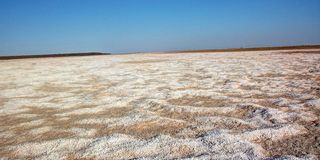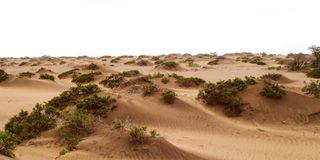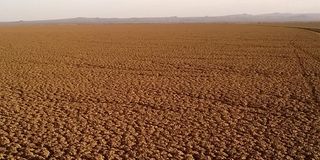Premium
Chalbi Desert rewrites Marsabit's marginalisation history

The Chalbi Desert dune belts.
For many years, the mention of Marsabit County conjured up images of a forsaken place full of hostile residents, banditry, cattle rustling and poor infrastructure and biodiversity.
But, after years of marginalisation with little economic growth, the county is slowly banking on tourism as a key driver of the economy.
To the county’s leadership, tourism is a low-hanging fruit which, if properly picked, could make a huge difference in the economy. Domestic tourism has remained low despite special promotional campaigns.
Foreign and local tourists have been trooping in and out of the county of late, triggering mushrooming of hotel industries and tourists travel agencies.
Thanks to the game changers: Isiolo-Moyale highway and the devolution system that have bolstered social currency and stamped the sense of validation of citizenship among the locals of Northern Kenya.

An aerial photo of local tourists marveling at the expansive Chalbi Desert on Sept.27, 2020
Radically altering the rhythms
Currently, a journey to and across Marsabit greets one’s eyes with a range of biodiversity under a succession of indigenous plants and wildlife that attest to the tenacity of life.
In a sense, undertaking a journey to Marsabit County is tantamount to a maiden homecoming even to a total stranger or a tour to the Arab cities like Abu Dhabi or Dubai.
You travel through vast plains, some littered with shrubs and lush trees, mountains, deserts, people, legends and history stitched together by the gleaming thread of one of the most attractive highways in Kenya -- the Isiolo-Moyale Highway.
Sometimes you get mesmerised by the occasional dust devils swirling across the highway like a rattlesnake on the hunt immediately you get past Merille trading centre to Moyale town.

The salt pan of Chalbi Desert.
According to Marsabit County Tourism and Culture Director Abdullahi Ibrahim, the region is rapidly growing into a new frontier of local, lifestyle and cultural tourism with a bouquet of diverse tourist attraction sites and biodiversity under a one-stop-shop.
Mr Ibrahim explained during an interview with Nation.Africa that the over 300 unique birds and thousands of animal species in Marsabit National Park were among other spectacular tourist attraction sites that have continued to stir interests regionally and abroad.
“We look forward to the day Marsabit county will be showcased by the Kenya Tourism Board on the magical website for its diverse and unique tourist attraction sites, especially the only desert in the entire East Africa -- Chalbi,’’ Mr Ibrahim said.
He said that the devolved unit was working with the KWS, KFS, Kenya Police Service, Kenya Tourism Board and investors to create the best tourist hub in the country.
He has also called on investors to capitalise on high-end desert camping and hotel facilities in the county, saying there were still enormous untapped opportunities.

Chalbi Desert dune belts
But, above all, the Chalbi desert in Marsabit County is gaining admiration for being the most enchanted and pristine ecotourism attraction scenery, espousing the rarest visibility -- enhancing events to the lovers of nature and adventure.
Chalbi is a Gabbra word meaning a salty lake.
It is one of the most breathtaking natural features and best-known natural landmarks of emblematic stature in Northern Kenya.
Surrounded by volcanoes and ancient lava flows, Chalbi Desert is one of the hottest and most arid places in Kenya.
As harsh and sparsely populated desert as it is, it is still known for its stunning natural beauty and towering dunes that began forming back in 2015.
This solitary and gigantic desert spans fabulously, so ungraspably back through history and has for centuries obsessed those who seek its origins.
It is a real gem stretching and tracing its way eastward of Lake Turkana and spreading to the Ethiopia-Kenya borders.
Dried up
Lake Turkana, the world’s largest permanent and alkaline lake, is believed to have been part of Chalbi Desert before it dried up 100 years ago.
It covers 100,000 square kilometres across from rim to rim in its stupendous proportion bordering Mt Kulal and Huri Hills towards the Ethiopian side.

The baked soil of Chalbi Desert.
It resembles a boiling lake from afar with a series of dazzling mirages seen during daylight. It is an ocean of cracked soil stretching from one horizon to yet another.
Upon setting foot on the enormous, grime smelling, parched earth with gaping cracks in the extensive salt plain that seems to beg for water due to the scarce annual rainfall in the area, one feels the pulse of this historical landscape.
Chalbi Desert does not have distinct temperature conditions. It has a semi-arid kind of climate.
February is the warmest month in Chalbi with temperatures shooting up to 40 degrees, while July is the coldest with temperatures going as low as 18 degrees. Temperatures drop sharply during the night. It can get chilly in the desert.
Inside Chalbi Desert, you can sight grizzlies with 20 square metres of dunes rippling like corduroy, huge salt pans ranging from extremely fine to very coarse and dry baked earth strewn all over.
The pans of salt are used by the pastoralists as a salt lick.
The northern part is home to the Rendille while the eastern part, towards the Ethiopian border, is home to the Gabbra community.
Amazingly, animal and bird life still thrive, and much of the terrain permits easy traversing by foot or vehicle when it is not raining.
Cursorily, there seems to be no sign of life in the desert while traversing it till you catch the marvels of guinea fowl, oryx, antelopes, ostrich or even the endangered Gravy zebras galloping across the great, shimmering whiteness or a few locals walking across the vast desert.
After the rains, the bone dry land turns into a shallow lake. On its northern peripheries, where the wind piles up dunes, a chain of oases nourishes vast palm groves, hinting at the existence of life there.
For the newly-wedded couples or those who could be oscillating midst rollercoasters of what feels like a series of survivable losses, Chalbi Desert is one of the most revitalising havens to be in.
Being one of the craziest natural phenomena around the globe, you will spot tourists taking selfies, photos of all sorts at the heart of the desert when it is not muddy while some flock to the neighbouring Kalacha springs, about 10km from the heart of the desert,. to cool their body temperatures.
The prized greenery attracts Gabbra pastoralists, who bring their camels in their hundreds to drink from the spring.
Celebration of life
Their colourful dresses, the singing and the dancing of their women during their cultural events, appear as a celebration of life in an otherwise hostile environment.
Even further north is the Hurri Hills, which comfort the sweating travellers with moderate temperatures in this seemingly boiling region.
On the eastern side is also North Horr where you can go and dip yourself in oases amid the sweltering heat.

An ostritch in the fringes of Chalbi Desert.
Chalbi Desert offers a perfect place for motorsports, wind sailing, camel derbies and caravans, filming, balloon flying and nature trips, among other adventures.
Going on a desert safari in Marsabit comes with game drives. To sum up such an experience, it is like having the deserts of Dubai and the Maasai Mara in Kenya mashed up in one region.
The lower temperatures and cool breeze in the evening, on the contrary, are a welcome relief from the often unbearable heat during day time, and explorers do enjoy activities that are otherwise difficult in high temperatures, such as bike riding.
Additionally, in the morning and evening, the stunning rising and setting sun rays offer therapeutic effects to the tired souls just by watching the exquisitely hanging orange orb in the sky.
It is quickly becoming a social meeting place for the young residents, where they gather to learn about and experience nature that improves the well-being of even the city dwellers who are fatigued by fast-paced lifestyles.
The most feasible access to the desert is by air (chopper) or road and preferably a high-clearance 4WD which is essential there all year round due to the rough terrain within and without the landscape.
The best time to visit the Chalbi Desert is during the dry seasons, from July to October and in January and February.
It is when the animals gather around the few remaining water sources and the dry terrain is much more conducive to game drives and safari walks.
Even such extreme conditions are no barriers to the enjoyment that comes with the greater appreciative exploration of the unique landmark.
On the flip side, the desertification has continued to expand to the nearing trading centres such as Maikona, Kalacha and North Horr due to the continued logging of the few trees available by the Gabbra communities during their traditional wedding ceremonies.
Marsabit County conservationist Joseph Maina said that eco-tourism should be promoted in the region to help find ways of preserving historical landscapes such as deserts that have been neglected through funding and planning.
Equally, Chalbi Desert Extreme Travel and Tourist Agency CEO Sarah Elema said that a lot of efforts were needed to market and develop local tourism which remains uncharted waters in the region.
“Marsabit is offering an alternative tourist destination away from conventional tourism especially during the Covid-19 crisis where congested places are avoided by many,” said Ms Elema.
She also observed that there was a need for the harnessing of the strong wind in the desert into electricity and exportation of the salt licks to create employment for local youths.





